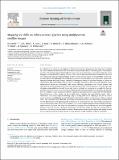Files in this item
Mapping ice cliffs on debris-covered glaciers using multispectral satellite images
Item metadata
| dc.contributor.author | Kneib, M. | |
| dc.contributor.author | Miles, E.S. | |
| dc.contributor.author | Jola, S. | |
| dc.contributor.author | Buri, P. | |
| dc.contributor.author | Herreid, S. | |
| dc.contributor.author | Bhattacharya, A. | |
| dc.contributor.author | Watson, C.S. | |
| dc.contributor.author | Bolch, T. | |
| dc.contributor.author | Quincey, D. | |
| dc.contributor.author | Pellicciotti, F. | |
| dc.date.accessioned | 2021-01-04T13:30:01Z | |
| dc.date.available | 2021-01-04T13:30:01Z | |
| dc.date.issued | 2021-02 | |
| dc.identifier | 271434804 | |
| dc.identifier | 3377b6e2-3250-48ec-a5f1-0410d415a964 | |
| dc.identifier | 85097089079 | |
| dc.identifier | 000604326500004 | |
| dc.identifier.citation | Kneib , M , Miles , E S , Jola , S , Buri , P , Herreid , S , Bhattacharya , A , Watson , C S , Bolch , T , Quincey , D & Pellicciotti , F 2021 , ' Mapping ice cliffs on debris-covered glaciers using multispectral satellite images ' , Remote Sensing of Environment , vol. 253 , 12201 . https://doi.org/10.1016/j.rse.2020.112201 | en |
| dc.identifier.issn | 0034-4257 | |
| dc.identifier.other | RIS: urn:623818AC340DB1BF5C6C508EC7C6EC46 | |
| dc.identifier.other | ORCID: /0000-0002-8201-5059/work/84315409 | |
| dc.identifier.uri | https://hdl.handle.net/10023/21215 | |
| dc.description | This project has received funding from the European Research Council (ERC) under the European Union's Horizon 2020 research and innovation programme grant agreement No 772751, RAVEN, “Rapid mass losses of debris covered glaciers in High Mountain Asia”. | en |
| dc.description.abstract | Ice cliffs play a key role in the mass balance of debris-covered glaciers, but assessing their importance is limited by a lack of datasets on their distribution and evolution at scales larger than an individual glacier. These datasets are often derived using operator-biased and time-consuming manual delineation approaches, despite the recent emergence of semi-automatic mapping methods. These methods have used elevation or multispectral data, but the varying slope and mixed spectral signal of these dynamic features makes the transferability of these approaches particularly challenging. We develop three semi-automated and objective new approaches, based on the Spectral Curvature and Linear Spectral Unmixing of multispectral images, to map these features at a glacier to regional scale. The transferability of each method is assessed by applying it to three sites in the Himalaya, where debris-covered glaciers are widespread, with varying lithologic, glaciological and climatic settings, and encompassing different periods of the melt season. We develop the new methods keeping in mind the wide range of remote sensing platforms currently in use, and focus in particular on two products: we apply the three approaches at each site to near-contemporaneous atmospherically-corrected Pléiades (2 m resolution) and Sentinel-2 (10 m resolution) images and assess the effects of spatial and spectral resolution on the results. We find that the Spectral Curvature method works best for the high spatial resolution, four band Pléaides images, while a modification of the Linear Spectral Unmixing using the scaling factor of the unmixing is best for the coarser spatial resolution, but additional spectral information of Sentinel-2 products. In both cases ice cliffs are mapped with a Dice coefficient higher than 0.48. Comparison of the Pléiades results with other existing methods shows that the Spectral Curvature approach performs better and is more robust than any other existing automated or semi-automated approaches. Both methods outline a high number of small, sometimes shallow-sloping and thinly debris-covered ice patches that differ from our traditional understanding of cliffs but may have non-negligible impact on the mass balance of debris-covered glaciers. Overall these results pave the way for large scale efforts of ice cliff mapping that can enable inclusion of these features in debris-covered glacier melt models, as well as allow the generation of multiple datasets to study processes of cliff formation, evolution and decline. | |
| dc.format.extent | 24400461 | |
| dc.language.iso | eng | |
| dc.relation.ispartof | Remote Sensing of Environment | en |
| dc.subject | Debris-covered glaciers | en |
| dc.subject | Supraglacial ice cliffs | en |
| dc.subject | Linear spectral unmixing | en |
| dc.subject | Sentinel-2 | en |
| dc.subject | Pléiades | en |
| dc.subject | Automated delineation | en |
| dc.subject | Ice cliff inventory | en |
| dc.subject | GE Environmental Sciences | en |
| dc.subject | NDAS | en |
| dc.subject.lcc | GE | en |
| dc.title | Mapping ice cliffs on debris-covered glaciers using multispectral satellite images | en |
| dc.type | Journal article | en |
| dc.contributor.institution | University of St Andrews. School of Geography & Sustainable Development | en |
| dc.contributor.institution | University of St Andrews. Bell-Edwards Geographic Data Institute | en |
| dc.contributor.institution | University of St Andrews. Environmental Change Research Group | en |
| dc.identifier.doi | https://doi.org/10.1016/j.rse.2020.112201 | |
| dc.description.status | Peer reviewed | en |
This item appears in the following Collection(s)
Items in the St Andrews Research Repository are protected by copyright, with all rights reserved, unless otherwise indicated.

